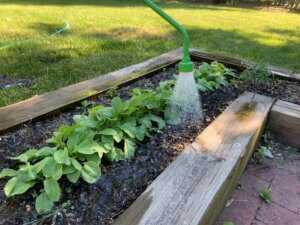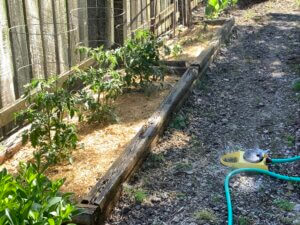Watering the Garden Just Right
Although recent rains have relieved some gardeners from their watering chores, the respite is sure to be temporary. Seasonal thunderstorms may deluge some gardens with water while other areas, even those close by, may stay fairly dry.
Most garden plants will need 1-1.5 inches of water per week to maintain healthy leaves, flowers and fruit. When Mother Nature does not provide enough, it’s up to the gardener to supply the rest. Not too little, not too much, but just right!
When you do need to water, it’s best to do a thorough deep application, and then put the hose away for the rest of the week. The worst thing you can do to your garden is to sprinkle lightly every day. Frequent, shallow watering only moistens the upper layer of soil, which encourages plant roots to stay shallow. In turn, that top layer of soil dries out quickly, making shallow-rooted plants more susceptible to drying. This holds true for lawns as well as garden and landscape plants.
It is also possible to kill your plants with kindness. Overwatering occurs when soil is kept too wet for too long, forcing valuable oxygen out of the soil. Oxygen is just as crucial to plant health as water. When heavy rains fall, or thorough irrigation is applied, don’t water again until the soil begins to dry. While you don’t want the soil to become so dry that plants begin to wilt, it is important to allow air to occupy some of the pore spaces in the soil between watering.
Newly set plants will need to be watered more frequently until they have a chance to establish new roots. Young vegetable or flower transplants may need to be watered every day or two, especially if the weather is sunny, hot and/or windy. Newly planted trees and shrubs may also need to be watered more frequently. But as the new plants become established, try to cut back on the frequency of watering.
Many plant fungal diseases are spread by splashing water during rain or irrigation. Drip or trickle irrigation will deposit the water low to the ground, keeping foliage dry; this is the most efficient way to deliver water only where needed. If watering must be overhead, try to water in the morning to promote quick drying and reduce loss due to evaporation.
July Garden Calendar
HOME (Houseplants and indoor activities)
Closely watch houseplants that have been set outdoors. They need more water than they did indoors. They can dry out rapidly in hot, summer breezes.
Propagate houseplants by taking cuttings from vigorously growing plants. Place the cut end in rooting media (such as perlite, vermiculite, or peat moss soil mix). Enclose in plastic and keep out of direct sunlight.
YARD (Lawns, woody ornamentals, and fruits)
Keep newly established plants watered during dry weather. Allow water to penetrate deeply into soil rather than sprinkling frequently and lightly.
Apply mulch around young plants to help conserve soil moisture and control weeds.
Do not plant bare-root or ball-and-burlap stock at this time of year. Container-grown plants still may be planted, but only if you can keep them well watered.
Continue a fruit tree spray program to keep diseases and insects under control.
Remove water sprouts (sprouts from the trunk) and suckers (sprouts from the roots) from fruit trees.
For those fortunate fruit tree growers who have a good crop this year, prop up tree branches that are heavily loaded with fruit.
Pinch off faded rose blossoms. Continue rose spray program to control insects and diseases.
Many Indiana trees are plagued by “lawnmower blight.” Be careful to avoid nicking tree trunks while mowing.
When watering lawns, apply 1 to 1.5 inches of water in a single application per week. Frequent, light sprinklings will encourage roots to stay shallow, making them more susceptible to drought.
Bluegrass is a cool-season plant and is under great stress during hot, dry summers. If water is not applied, the bluegrass will become dormant and will turn brown, until more favorable conditions arrive in autumn. For extreme dry conditions, rescue watering is required to keep the plants alive, while still dormant. Apply one-half inch of water every 2-4 weeks.
Mow grass one-half inch higher than usual during the dry, summer months to help conserve soil moisture. Do not mow when the lawn is under severe drought stress.
No need to remove clippings from the lawn unless grass is excessively tall or weedy. Clippings return some nutrients to the soil and do not add to thatch buildup.
GARDEN (Vegetables, small fruits, and flowers)
Supplement natural rainfall, if any, to supply 1 to 1.5 inches of water per week in a single application.
Start seeds of broccoli, cabbage, and Brussels sprouts to transplant later for a fall harvest.
Harvest crops such as tomatoes, squash, okra, peppers, beans, and cucumbers frequently to encourage further production.
Complete succession planting of bush beans and sweet corn.
Harvest summer squash while small and tender for best quality.
Standard sweet corn is at its peak for only a day or so. Supersweet corn varieties maintain their peak quality for a longer period. Harvest when silks begin to dry and kernels exude a milky, rather than watery or doughy, juice when punctured.
Broccoli will form edible side shoots after the main head is removed.
Mulch garden to control weeds and conserve soil moisture.
Make sure potato tubers, carrot shoulders, and onion bulbs are covered with soil to prevent them from developing a green color and off flavors. Applying a layer of mulch will help keep them covered.
Allow blossoms on newly planted everbearing strawberry plants to develop for a fall crop.
July is a good time to fertilize strawberries with 0.5 pound of actual nitrogen per 100 feet of row.
Harvest raspberries when fully colored and easily separated from stem. After harvest is complete, prune out the fruiting canes to make room for new growth.
Remove faded blossoms from annual and perennial flowers to prevent seeds from forming.
Condition flowers cut from the garden for arranging by removing the lower leaves, placing cut stem ends in warm water, and storing them overnight in a cool location.
The foliage of spring-flowering bulbs can be removed safely after it fades. This also is a good time to lift the bulbs for transplanting or propagation.

